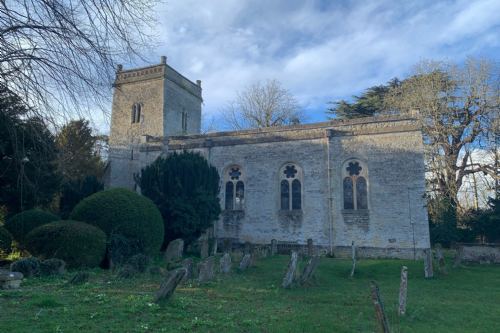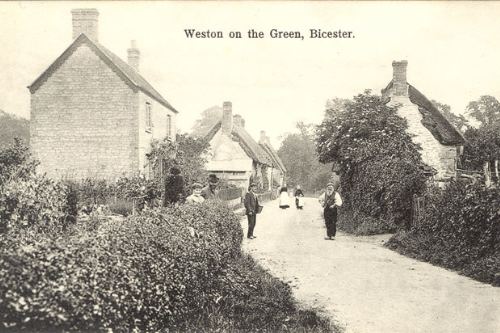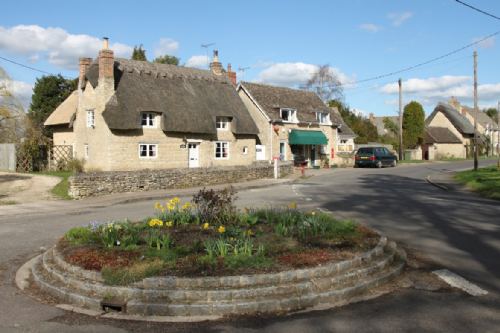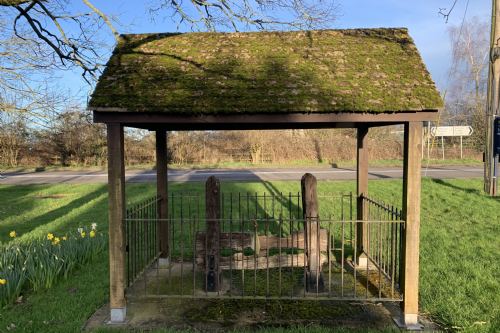History of Weston on the Green
Overview
Weston on the Green is a parish of around 260 homes situated approximately 4 miles to the south-west of Bicester. The stocks date from the 18th century, or earlier and there are many thatched buildings. The Manor House is now a hotel and the church is mainly 18th century with a 13th century tower and Victorian additions.
There is evidence relating to the Bronze Age, Roman and Saxon eras within the parish with the Roman Akeman Street forming part of the northern boundary.
Evidence of medieval farming remains in the ridge and furrow contours of the School Field.
Following the Norman Conquest, in 1066, Weston appears in the Domesday Book as a small holding of about 30 people. Ownership passed to the D’Oilly family, who had come with William the Conqueror. Over the next two centuries most of Weston passed into the hands of Oseney Abbey where it remained until the Dissolution of the Monasteries in the 16th century when Henry VIII passed it to Lord John Williams of Thame. The Manor remained with Lord Williams’s descendants – the Norreys and Bertie families until, 358 years later, the estate was sold in 1918.
The Church 
The tower is older than the main body of the church and is thought to date from the 13th century. The first written evidence of religion comes in the 12th century when Wakelin, priest of Weston, was a signatory to a document.
Although now dedicated to St Mary the Virgin, the church once also had altars to St James the Apostle and St Nicholas the Confessor and there are later references to St Bartholmew.
Following a period of neglect the fabric of the original stone building was in such bad repair that it was rebuilt in the Georgian style by the then Lord of the Manor, Norreys Bertie and his initials and the date – 1743 – appear on the rainwater hoppers.
The church has 6 bells, one dating from the 21st century, the remaining 5 being Victorian recasts of bells originally dating from the 15th, 16th and 17th centuries.
The Victorians also gave the church a porch, an organ and repairs to both the roof and the interior of the building.
Perhaps the most unusual features of the building are the painting above the altar and the Armada Cross.
Information sheets on the history of the Church and Churchyard (detailed below) have been produced and can also be found in the entrance of the Church (should you wish to obtain a printed copy please don't hesitate to contact the clerk):
- Church History - Building Overview
- Church History - Interior
- Church History - War Memorials
- Church History - Churchyard Tour
- Priests, Vicars, Curates and Incumbents of Weston on the Green
Much information relating to the village has been gleaned from three documents, two now in the County Records Office and one still in private hands, which have been worked on in detail. Essays covering them can be accessed via the links to:-
Churchwarden’s Book 1767-1917 by Brian Wilson and Paula Hessian.
Overseers Book 1831-1845 by Brian Wilson and Paula Hessian.
The Constable’s Book 1797 – 1843 by Brian Wilson.
'The Turnpike Road’ - A talk given by Brian Wilson to the Weston Society.
Information on Church Records is available by request to the Village Archive (phessian48@gmail.com) or from the County Records Office (Oxfordshire History Centre) who hold original documents dating from 16th century.
The Chapel
Now incorporated into a private dwelling, Weston’s Methodist Chapel was one of the earliest in the area, built “by the labour of their own hands” in 1838. They celebrated their centenary in 1938 with the publication of a booklet covering much of the history of the village over the preceding 100 years. Falling numbers finally made the upkeep of the building too difficult and the building was closed and sold off in 1993. Since then non-conformist services have been held in both the church and village hall at different times but generally worshipers have to travel to Bicester for the nearest chapel.
The text of the celebration book printed in 1938 can be obtained from the Village Archive.
The Manor
The Manor building dates in part from the 15th and early 16th centuries and so the oldest remaining parts were in use by Oseney Abbey’s bailiff. The remains of the 13th century moat can still be seen – just one side on the western edge of the present gardens. The north facing range of buildings are the oldest with the post medieval west range being added later. Further additions in the 16th, 17th and 18th centuries were then followed by a Victorian make-over to present a 19th century idea of a medieval manor house. Internally much has changed, although fire surrounds, doors and panelling remain to tell the story of progress from a bailiff’s residence under the ownership of Oseney Abbey, from the 11th to the 16th century, followed by an often tenanted house in the ownership of the Norreys and then Bertie families until finally, in the mid 19th century, becoming the family home of the Berties until 1918 when the Manor and most of the village were sold.

The Village Hall
The first Village Hall opened in 1921, a wooden structure providing a home for the Village Club and being a Memorial to those from the parish who did not return from the First World War. The site had been donated for this purpose and, when this hall became too dilapidated to be used, it was replaced by the present, purpose built building, which opened in 1973. Since the erection of the first hall it has been used by village organisations and been the centre of village activities ranging from mother and baby groups through toddler and playgroups to an overflow classroom for the school. It has also been used as the showplace for the Horticultural Society and the meeting place for many other groups covering all ages up to the Get Together Club and the present day Golden Leaves Lunch Club.
The School
A school existed in Weston as early as 1808, with around 20 pupils. These pupils paid for their education – a few pence each week. In 1855 there was a school recorded as being in the thatched building at the end of North Lane, where it remained until its closure in 1984. As one of only two thatched schools in the county it was sold off and is now a private residence.
The school bell was removed from the school and now hangs in the Memorial Village Hall. The school honours board is stored in the Oxfordshire Museum Store at Standlake.
The surviving log books, dating from 1873 are in the County Records Office and a transcript is held in the Village Archive.
Public Houses
Since the 18th century, Weston has had two public houses – The Chequers and The Ben Jonson - both buildings have long been part of the history of the village.
Ben Jonson, like Shakespeare, was an eminent writer for the Elizabethan stage. Born in 1572, the son of a clergyman, Jonson became an actor for a theatrical company in London before becoming a playwright. His colourful life, including imprisonment for seditious writings and involvement in a fatal duel are all recorded BUT there is no evidence that he ever came to Weston, nor is there evidence that he might have “passed through” Weston to visit Stratford Upon Avon, the birthplace of his contemporary William Shakespeare (1564-1616). Once established in London, William only returned to Stratford for short visits. Ben Jonson did walk from London to Edinburgh although the reason for this journey and the route taken are not known. Ben Jonson died in 1637.
The first reference to there being two alehouses in Weston is in 1691 but it is over 60 years later that the Ben is identified by name. The first named licensee of the Ben was Edward Mann who may have been the son of a previous landlord. Edward’s father, John, probably married about the time of Ben Jonson’s death – was he a fan of the playwright? That’s as near as we can get!
The Chequers is also recorded, by name from the mid 18th century, although was probably here at least as early as the last half of the 17th century. Its name is not as unusual or rare as the Ben’s name. The large forecourt was used to enable coaches, carts and delivery drays to turn. For many years it was the scene of annual dances and was the village meeting house for organisations like the Friendly Society. The Chequers hit the local headlines in the mid 20th century when building work to join the two buildings was found to be in contravention of the Public Footpath Laws and, until a re-routing of the path was granted the landlord had to keep the front and back doors open to enable the footpath to be used. And the name of the landlord at the time – Mr Bill Christmas.
Weston Matters
The original ‘Weston Matters – Our Village and its People’ book written by Paula Hessian and Margaret Fissenden was printed in 2000 and is now out of print, but second hand copies do appear on the internet. The book was re-printed in 2020 with an added ’20 years on’ chapter.
The Weston Society meets regularly to enjoy speakers on many topics ranging from local history, the environment, both built and natural, and the people and activities specific to our area.

Weston Airfield
Weston on the Green airfield is located to the north of the village. The airfield was built by German prisoners of war and Canadian military personnel in 1915 for the Royal Flying Corps. During its construction a railway line was built connecting it to the main railway line between Oxford and Bicester. It was closed in 1921 and redeveloped when a number of the original buildings were demolished. The former RFC Officers and Sergeant’s messes were located on the opposite side of the B430 road and are now in commercial use. After the war the land returned to agricultural use.
In 1940 Winston Churchill ordered the formation of 5,000 airborne troops and also a glider regiment to accompany them. Weston on the Green was one of the sites chosen to train glider pilots and by 1942 it was a very busy airfield with up to 80 aerotows a day during the summer. Although it was just a satellite airfield for Brize Norton, it received more bombs than any other airfield in Oxfordshire during WW2.
With victory in sight the training of glider pilots decreased and by 1946 control of the airfield was passed to Upper Heyford who subsequently designated it as a dropping zone for parachutists under training until 1951.
In 1967 the airfield was used for the launch of the first modern hot air balloon in the UK, called the Bristol Belle. It was created from an idea developed by members of the Bristol Gliding Club and Wing Commander Gerry Turnbull, then based at RAF Weston on the Green, was brought in as an experienced gas-balloon pilot, to teach the team how to fly it.
The airfield is currently a parachute training station, under the control of RAF Brize Norton, and is one of the few remaining active RAF bases with some original pre-RAF buildings. The grass airfield is used regularly as a drop zone for military static line and freefall parachute training for the UK military. No military aircraft are based at RAF Weston on the Green and the airfield is manned only part-time by RAF personnel.
The airfield is also used by the Oxford Gliding Club.
The airfield is situated in the middle of its own protected airspace and it is said that on a day with good visibility the city of Oxford, London to the southeast and the Malvern hills to the west can be seen.
Oxfordshire History Websites
Bicester Local History Society - monthly historical talks
Oxfordshire History Centre - County Records Office
Oxfordshire Museum Store at Standlake
Oxfordshire Family History Society
GenUKI - Oxfordshire Genealogy
The Parish Council would like to thank Paula Hessian, our amazing Parish historian, for all her knowledge and time spent putting this information together along with previous support and documentation from the late Margaret Fissenden and Brian Wilson.
Please don't hesitate to contact the Village Archive (phessian48@gmail.com) should you want to find out more information.


